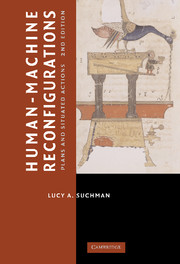Book contents
- Frontmatter
- Contents
- Acknowledgments
- Preface to the 2nd Edition
- Introduction
- 1 Readings and Responses
- 2 Preface to the 1st Edition
- 3 Introduction to the 1st Edition
- 4 Interactive Artifacts
- 5 Plans
- 6 Situated Actions
- 7 Communicative Resources
- 8 Case and Methods
- 9 Human–Machine Communication
- 10 Conclusion to the 1st Edition
- 11 Plans, Scripts, and Other Ordering Devices
- 12 Agencies at the Interface
- 13 Figuring the Human in AI and Robotics
- 14 Demystifications and Reenchantments of the Humanlike Machine
- 15 Reconfigurations
- References
- Index
- Frontmatter
- Contents
- Acknowledgments
- Preface to the 2nd Edition
- Introduction
- 1 Readings and Responses
- 2 Preface to the 1st Edition
- 3 Introduction to the 1st Edition
- 4 Interactive Artifacts
- 5 Plans
- 6 Situated Actions
- 7 Communicative Resources
- 8 Case and Methods
- 9 Human–Machine Communication
- 10 Conclusion to the 1st Edition
- 11 Plans, Scripts, and Other Ordering Devices
- 12 Agencies at the Interface
- 13 Figuring the Human in AI and Robotics
- 14 Demystifications and Reenchantments of the Humanlike Machine
- 15 Reconfigurations
- References
- Index
Summary
Once the European navigator has developed his operating plan and has available the appropriate technical resources, the implementation and monitoring of his navigation can be accomplished with a minimum of thought. He has simply to perform almost mechanically the steps dictated by his training and by his initial planning synthesis.
(Gladwin 1964: 175)Every account of communication involves assumptions about action, in particular about the bases for action's coherence and intelligibility. This chapter and the next discuss two alternative views of action. The first, adopted by most researchers in artificial intelligence. locates the organization and significance of human action in underlying plans. At least as old as the Occidental hills, this view of purposeful action is the basis for traditional philosophies of rational action and for much of the behavioral sciences. It is hardly surprising, therefore, that it should be embraced by those newer fields concerned with intelligent artifacts. particularly cognitive science and information-processing psychology. On the planning view, plans are prerequisite to and prescribe action, at every level of detail. Mutual intelligibility is a matter of the reciprocal recognizability of our plans, enabled by common conventions for the expression of intent and shared knowledge about typical situations and appropriate actions. The alternative view, developed in Chapter 6 of this book, is that although the course of action can always be projected or reconstructed in terms of prior intentions and typical situations, the prescriptive significance of intentions for situated action is inherently vague.
- Type
- Chapter
- Information
- Human-Machine ReconfigurationsPlans and Situated Actions, pp. 51 - 68Publisher: Cambridge University PressPrint publication year: 2006



